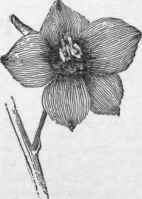Delphinium. Part 2
Description
This section is from the book "The Standard Cyclopedia Of Horticulture Vol2", by L. H. Bailey. See also: Western Garden Book: More than 8,000 Plants - The Right Plants for Your Climate - Tips from Western Garden Experts.
Delphinium. Part 2
2. Consolida, Linn
(Consolida arvensis, Opiz). An erect, hairy annual, 1-1 1/2 ft. high: leaves similar to D. Ajacis: flowers few, loosely panicled, pedicels shorter than the bracts, blue or violet or white; petals 2, united: follicle 1, glabrous; seeds with broken, transverse ridges. June-Aug. Eu. Baxter Brit. Bot. 4, t. 297. R.H. 1893, p. 228 (variety ornatum Candelabrum). G.Z. 15:81. variety imperialis, Hort. (D. imperialis flower pl., Hort.). Flowers double. From the English gardens. - See above species for sowing of seeds.
aa. Perennials, pure species: petals 4' follicles 3-5 (Nos. 3-27).
b. Sepals red.
3. Nudicaule, Torr. & Gray
stem 1-1 1/2 ft. high, glabrous, branched, few-lvd.: leaves rather succulent, 1-3 in. across, lobed to the middle or farther 3-7 times, the secondary lobes rounded and often mucronate; petioles 3-5 in. long, dilated at the base: flowers panicled; sepals bright orange-red, obtuse, scarcely spreading, shorter than the stout spur; petals yellow, nearly as long as sepals: follicles 3, spreading and recurved, soon becoming glabrous; seeds thin-winged. Apr-July. Along 'mountain streams, N. Calif. B.M.5819. F.S. 19:1949. R.H. 1893, p. 259. - A good perennial in the E.
4. Cardinale, Hook
stem erect, 2-31/2 ft. high and much higher under favorable conditions, partly pubescent: leaves smooth, fleshy, deeply 5-parted, the parts cut into long, linear lobes: raceme elongated, many-fid.; flowers bright red, with petal-limbs yellow: follicles glabrous, usually 3; seeds smooth. July, Aug. S. Calif. B.M. 4887. Gt.
6:328. F.S. 11:1105. R.B. 6:101. Gn. 19:234.
bb. Sepals clear yellow or tipped with blue.
5. Przewalskii, Huth (D. Prsewalskianum, Hort.)
Nearly glabrous, often branched at base, erect, varying much in height: leaves 3-5 times deeply parted, parts divided into narrow, obtuse lobes: flowers clear yellow, or sometimes tipped with blue; spur equaling the sepals: follicles 3, densely hairy. July, Aug. Asia. - introduced 1892. 6. Zalil, Aitch. & Hemsl. (D. sulphureum, Hort. D. hybridum variety sulphureum, Hort.). stem nearly simple, erect, 1-2 ft. high, rather glabrous, or becoming so: leaves of several narrow, linear lobes, dark green; petioles not dilating at the base: flowers large, light yellow, in long racemes: follicles 3, longitudinally furrowed and ribbed; seeds with transverse, fibrous plates. June, July. Persia. introduced 1892. B.M. 7049. Gn. 50:434; 54, p. 347; 71, p. 285. G. C. III. 20:247. - Seedlings from tubers and plants die down as if dead; but they make a second growth after a short period of rest.

Fig. 1232. Single larkspur. -D. grandiflorum.
bbb. Sepals blue or varying to white.
c. Height l 1/2ft.or less.
d. Petioles dilating at the base.
7. Bicolor, Nutt
Erect, rather stout, 1/2-1 ft. high, from fascicled roots: leaves small, thick, deeply parted and divisions cleft, except perhaps in the upper leaves; segments linear and obtuse: raceme rather few-flowered, the lower pedicels ascending 1-2 in.; spur and sepals nearly equal, 1/2in. long or more, blue; upper petals pale yellow or white, blue-veined; lower petals blue: follicles glabrous or becoming so. May-Aug. Dry woods, Colo., west and north to Alaska.
8. Brunonianum, Royle
Musk Larkspur. stems erect, 1/2- 1 1/2 ft. high: plant somewhat pubescent: upper leaves 3-parted, lower ones reniform, 5-parted; segments deeply cut, musk-scented: flowers large, light blue with purple margins, center black; spur very short; sepals 1 in. long, membranous and often clinging until the fruit is mature: follicles 3 or 4, villose. June, July. China. B.M. 5461. R.B. 1863:34.
9. Decorum, Fisch. & Mey
stem slender and weak, 1/2- 11 /2 ft- high, smooth or nearly so: leaves few, bright green; upper ones small, 3-5-parted into narrow lobes; lower and radical ones somewhat reniform in outline and deeply 3-5-parted, lobes often differing widely: flowers in a loose raceme, or somewhat panicled; sepals blue, 1/2in. long, equaling the spurs; upper petals at least tinged with yellow: follicles 3, thickish, glabrous. Spring. Calif. introduced 1881 B.R. 26:64.
dd. Petioles hardly dilating at the base. e. Upper petals never yellow.
10. Cashmerianum, Royle
Plant pubescent, not very leafy: stem simple, erect, slender, 10-18 in. high: root-leaves orbicular, 2-3 in. diam., 5-7-lobed, coarsely, acutely toothed and cut; petiole 5-8 in. long; stems - leaves short-petioled, 3-5-lobed, cut like the radical ones, all rather thick, and bright green: infloresence corymbose, the branches rather spreading; flowers 2 in. long, deep azure-blue; spur broad, obtuse, inflated, decurved, little over half as long as sepals; upper petals almost black, 2-lobed, lateral ones greenish: follicles 3-5, hairy. July-Sept. Himalayas. B.M. 6189. Gt. 32:1105. Gn. 18:568. R.H. 1893, p. 259. - Hardy in Mass., and choice.
Variety Walkeri, Hook. stem very short, leafy, many-flowered: upper leaves less lobed or almost entire, small, long-petioled: flowers very large, light blue with yellow petals. Suited to rockwork. B.M. 6830.
ee. Upper petals yellow or striped with yellow.
11. Tricorne, Michx
stem succulent, about 1 ft. high: leaves 3-5-parted, with 3-5-cleft linear lobes; petioles smooth, hardly dilating at the base: flowers large, blue, rarely whitish; upper petals sometimes yellow, with blue veins, lower ones white-bearded; sepals nearly equaling the spur: follicles 3-4, very long, becoming glabrous, strongly diverging; seeds smooth. May. Northern states. L.B.C. 4:306. - Very beautiful and much used. Best for rockwork. The foliage dies down in midsummer and the plant appears as if dead.

Continue to:


